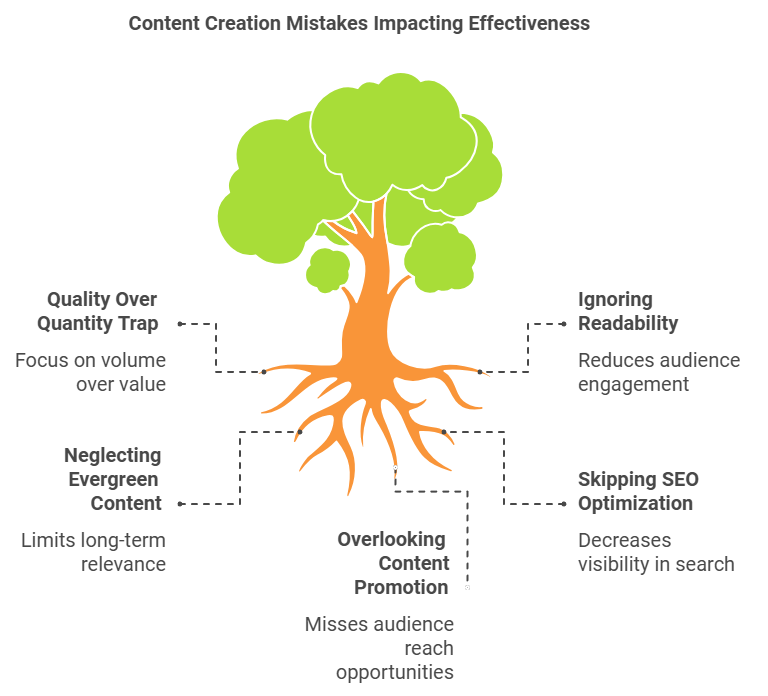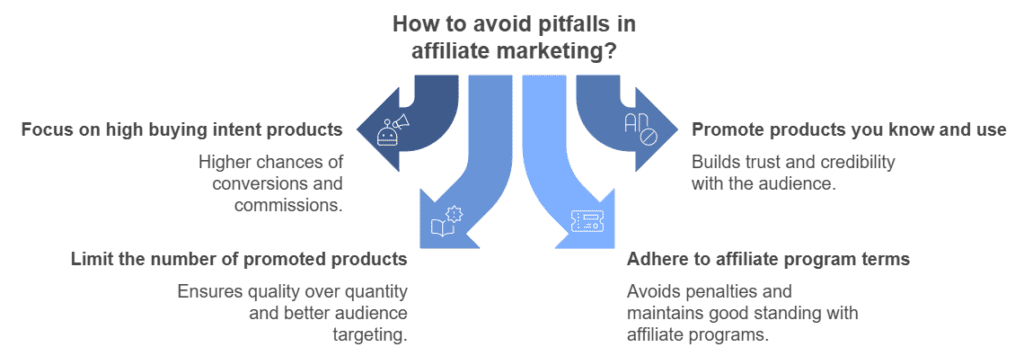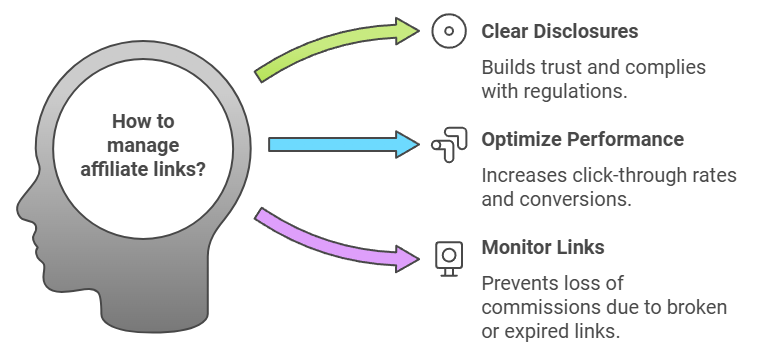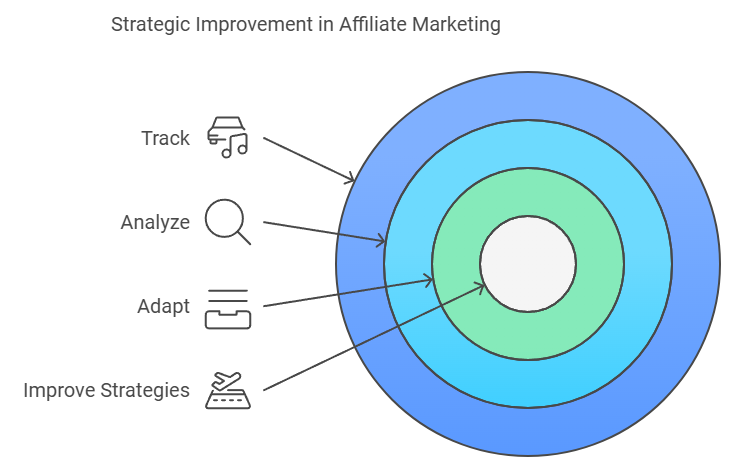Estimated reading time: 24 minutes
The Allure and Challenges of Affiliate Marketing
Affiliate marketing—it’s that dream gig that lets you work from anywhere, be your own boss, and build a steady stream of passive income. Imagine sitting at a beach, sipping on a cold drink, while your business keeps earning. That’s the allure, and it’s very real. But here’s the truth that a lot of so-called experts won’t tell you: Affiliate marketing is not a shortcut to riches. It takes strategy, grit, and a willingness to learn from your mistakes.
So, what is affiliate marketing exactly? It’s a business model where you earn a commission by promoting other people’s products or services. The more effectively you market, the more you make. Simple, right? Well, not quite.
The truth is, many people dive into affiliate marketing expecting overnight success. They overlook the challenges, make avoidable mistakes, and end up frustrated. Here’s where this guide comes in—I’m here to help you sidestep the pitfalls and accelerate your journey to success.
In this post, I’m going to break down the most common mistakes affiliate marketers make and how you can avoid them. My goal? To help you stay ahead of the competition, save time, and maximize your profits. It’s about working smarter, not harder, and this guide will show you exactly how to do just that.
Let’s get started.
Looking for something else?
Content Creation Mistakes That Can Sabotage Your Efforts
Crafting Content That Converts: Avoiding Content Creation Pitfalls
The Quality Over Quantity Trap
Creating content just for the sake of volume? That’s a surefire way to tank your affiliate marketing journey before it even starts. Let’s get one thing straight: quality content trumps quantity every time. You might think that pumping out dozens of blog posts, articles, or product reviews will help your website rank faster and pull in more traffic. But if that content is thin, repetitive, or riddled with irrelevant keywords, you’re not just wasting time—you’re actively damaging your credibility.
Low-quality content can take many forms: thin content that offers little to no real value, keyword stuffing that makes your text read like a bot, or duplicate content that makes Google wonder if your site offers anything unique. None of these approaches work, and in fact, they often result in lower rankings and higher bounce rates.
Instead, focus on creating in-depth, engaging content that truly addresses the needs of your target audience. Solve their problems, answer their questions, and offer real insights that make them stick around. Use engaging content strategies that include storytelling, sharing personal experiences, and addressing reader intent directly. In-depth guides, how-to articles, and story-driven blog posts tend to perform far better than a bunch of poorly-written fluff.
Need proof? A study by HubSpot shows that content that’s over 2000 words tends to rank higher and perform better in terms of social shares and backlinks. But it’s not just about length; it’s about depth, relevance, and value.
Key takeaway: Stop churning out mediocre articles. Instead, focus on crafting fewer but highly valuable pieces that address reader intent and offer real solutions. This helps build a robust content strategy that boosts your credibility.
Ignoring Readability and User Experience
Poor readability is a killer for both user experience and SEO. Imagine clicking on a blog post only to be met with an unbroken wall of text, or a confusing layout that makes it impossible to follow the author’s train of thought. The back button becomes really tempting, doesn’t it?
When users struggle to read your content, they leave. This results in a high bounce rate and lower rankings. To avoid this, you need to prioritize readability to ensure that your content creation efforts aren’t wasted:
- Use short paragraphs and simple sentences to improve readability.
- Break up your content with headings and bullet points to guide the reader.
- Choose a readable font size and ensure proper line spacing for better user experience.
- Make smart use of white space and include visuals to aid understanding and enhance content engagement.
- Ensure your website is mobile-friendly. Over 50% of web traffic is from mobile devices—ignoring this audience could cost you heavily.
Remember, even the best information is useless if readers can’t comfortably consume it. Content optimization means not only ensuring your content is visible but that it is also easy and pleasant to read.
Key takeaway: Make your content easy to read. Focus on clean formatting, short paragraphs, and mobile optimization to keep users engaged and to make your content creation efforts more effective.
Neglecting the Power of Evergreen Content
Evergreen content is the gift that keeps on giving. Unlike trending topics that fade, evergreen content remains relevant for years, pulling in consistent traffic and providing ongoing value. Ultimate guides, how-to tutorials, and resource lists are all fantastic examples of evergreen content that can boost your blog post rankings over time.
The benefits? Consistent traffic, authority building, and lasting SEO value. But remember, even evergreen content needs maintenance. Regular updates are key to keeping it fresh and relevant. A guide you wrote two years ago could have outdated stats or irrelevant links—keep revisiting your content to ensure it’s accurate and useful.
Key takeaway: Invest in evergreen content to provide lasting value and keep updating it to stay relevant. Quality content that is evergreen will always help in maintaining long-term user engagement and authority.
Skipping Keyword Research and SEO Optimization
Keyword research is not optional—it’s the core of any good content strategy. Without it, you’re essentially shooting in the dark, hoping the right audience finds your content. The goal of keyword research is to identify the search terms that people in your niche are actually using so you can create blog posts and articles that address those needs.
Here’s how to do it effectively:
- Use Tools: Tools like Ahrefs, SEMrush, or even Google Keyword Planner can help identify relevant keywords.
- Focus on Intent: Understand the reader intent behind keywords—are people looking for information, or are they ready to buy?
- Optimize On-Page SEO: Incorporate your keywords naturally in title tags, meta descriptions, header tags, and throughout your content. Also, optimize your images with alt text and make sure your site speed is up to par.
Neglecting SEO doesn’t just mean fewer visitors—it means wasting the effort you put into content creation in the first place.
Key takeaway: Always do your keyword research and optimize for both search engines and user experience. This is what drives organic traffic and ensures your content reaches the right audience.
Overlooking the Importance of Content Promotion
Creating great content is only half the job. The other half? Promoting it effectively. If you’re not pushing your content out there, it won’t reach the audience you need, no matter how good it is.
Consider the following strategies for effective content promotion:
- Social Media: Share your content across platforms like Facebook, Twitter, and LinkedIn to expand visibility.
- Email Marketing: Build an email list and promote your content directly to people who want to hear from you.
- Outreach: Connect with other bloggers or industry leaders and ask for backlinks or shares. This helps drive organic traffic and boosts SEO.
- Paid Promotion: If it fits your budget, consider paid ads to boost the visibility of important pieces of content.
Key takeaway: Content promotion requires time and effort. Don’t assume great content will promote itself—have a strategy in place to actively distribute it. This is crucial for increasing visibility and ensuring your content strategy reaches its potential.

Niche and Product Selection Errors That Cost You Money
Choosing Your Battlefield Wisely: Mistakes to Avoid in Niche and Product Selection
Falling for the Low Buying Intent Trap
One of the biggest mistakes in affiliate marketing is picking a niche with low buying intent. If people aren’t ready to make a purchase, you’re wasting time, energy, and money promoting products they don’t want. Buying intent is the difference between someone browsing for ideas and someone ready to hit the “buy now” button. Focus on finding markets where people are ready to spend.
Niches with low buying intent are often based on curiosity rather than a direct problem-solving need. Think about areas like general lifestyle advice or broad motivational quotes—sure, people might be interested, but are they really looking to buy anything? Compare that to niches like home office equipment or fitness gear where people are actively searching for the best products to invest in. You want to be in the latter camp, where people are ready to swipe their card.
To identify niches with high buying intent, pay attention to the keywords. If you see phrases like “best,” “buy,” “review,” or “discount,” you know people are looking to make a decision. Market research is also critical—analyze your competitors, see what’s selling, and figure out which niches are consistently profitable. Don’t be afraid to use tools like Google Trends or Ahrefs to dig deeper into product demand and see where you can carve out a profitable spot for yourself. For example, niches like ‘pet grooming tools’ or ‘ergonomic office chairs’ often show strong buying intent as people are actively looking for solutions to specific needs.
Key takeaway: Focus on niches that address an immediate need or solve a specific problem with high buying intent. These niches are where customers are ready to take action, often because they have an urgent issue or a clearly defined problem that requires a solution. Choosing a niche that reflects high buying intent ensures your audience is already inclined to purchase, allowing you to capitalize on this demand effectively. Stop wasting time in markets that don’t convert, and instead channel your efforts into areas where people are motivated to make buying decisions quickly.
Promoting Products You Don’t Know or Use
Promoting products you don’t know inside and out? That’s a quick way to lose credibility. Your audience can tell when you’re faking it, and nothing turns them away faster. If you’re not willing to use the product yourself, how can you expect others to trust your recommendation? Personal experience builds trust—plain and simple.
Instead of grabbing any affiliate link that promises a commission, invest time in researching and testing the products. Read customer reviews, compare features, take advantage of free trials, or even reach out to companies for samples. For example, I once promoted a fitness tracker after testing it for a month, noting how it improved my daily step count and helped me stay accountable. This approach helps you create honest product reviews and provides the social proof that your audience needs to feel confident. Remember, authenticity is what wins the day—people want to hear about real experiences, not a rehashed sales pitch.
Key takeaway: Promote only what you know and use. Trust comes from genuine recommendations based on real experience.
Spreading Yourself Too Thin: The Dangers of Promoting Too Many Products
It’s tempting to think that promoting more products will automatically lead to more earnings. However, focusing on too many products dilutes your efforts and leaves your audience confused. By narrowing your focus to a few well-chosen, high-quality products, you can provide in-depth insights that establish you as a trusted authority. Specializing allows you to create content that truly adds value—whether through detailed product comparisons, comprehensive guides, or focused how-to articles. Quality over quantity is the winning strategy.
Specializing allows you to create in-depth content that adds real value, whether it’s product comparisons, detailed guides, or how-to articles that answer your audience’s questions. Not only does this build your authority, but it also drives higher conversion rates because your audience trusts your expertise. To select the right products, consider audience needs, analyze commission rates, and test product conversions to ensure you’re promoting only the best options that align with your brand.
Key takeaway: Less is more. Focus on a few reliable products and become an authority. Your audience will thank you with their trust and, more importantly, their purchases.
Ignoring Affiliate Program Terms and Conditions
You want to make money, not lose it all because of a silly oversight. Ignoring the terms and conditions of an affiliate program is a rookie mistake that can cost you everything. Each affiliate program has its own set of rules—some might limit how you can promote their products, others have strict guidelines on where you can place affiliate links. Violating these can lead to account suspension or even termination without warning.
Common mistakes include spamming affiliate links on forums or social media, using misleading marketing practices, or even inadvertently violating copyright laws by using unapproved images. To avoid these pitfalls, use tools like Canva for compliant visuals, and ensure you follow best practices by keeping affiliate links relevant and avoiding misleading claims. Take the time to read and understand each program’s terms. If anything is unclear, contact the affiliate manager. Staying compliant protects your income and builds a good relationship with vendors, making you a trusted partner.
Key takeaway: Read the rules. Understand the requirements of each affiliate program you join. Compliance ensures your income is safe and your reputation intact.
These are some of the common pitfalls that can hold back your affiliate marketing success. Avoiding these mistakes will help you pick the right niches, promote products that add real value, and stay compliant to protect your income. Remember, affiliate marketing is about playing the long game—and that means focusing on trust, quality, and strategic decision-making.
Ready for the next step? Let’s keep sharpening your strategy until there’s no room left for failure.

Affiliate Link Management and Disclosure Mistakes That Can Hurt Your Credibility
Maintaining Transparency and Trust: Affiliate Link Management and Disclosure Best Practices
The Importance of Clear and Conspicuous Affiliate Disclosures
If you want to succeed in affiliate marketing, there’s no getting around it—transparency is non-negotiable. Disclosing your affiliate relationships is essential, not just for ethical reasons, but also to comply with legal requirements. Your audience deserves to know when you’re earning a commission. It’s about trust—when people trust you, they’re more likely to buy through your links.
To effectively disclose affiliate links, use clear and concise language. Don’t bury your disclaimer in fine print or at the very bottom of the page where no one will see it.
Instead, include it at the beginning of your posts, or even right before the affiliate link itself. For blog posts, place the disclosure near the introduction; for videos, mention it verbally within the first minute; and for social media, include it in the caption or prominently within the post. Statements like, “This post contains affiliate links, which means I may earn a commission at no extra cost to you,” are direct and clear. You can also use affiliate link disclosure plugins to make sure every page complies consistently.
Failing to disclose your affiliate links properly can lead to serious consequences—damaged reputation, loss of audience trust, and even legal penalties. The Federal Trade Commission (FTC) in the U.S. requires these disclosures, and not complying could get you into a lot of trouble. In an online world built on trust, don’t gamble with your reputation.
Key takeaway: Be upfront about affiliate links. Disclose them clearly and prominently to maintain trust and avoid legal issues.
Managing Affiliate Links for Optimal Performance
Proper affiliate link management isn’t just about compliance—it’s about optimizing for better conversions and improved user experience. That’s where link cloaking comes into play. Cloaking makes your affiliate links more user-friendly and aesthetically pleasing. Instead of a long, messy URL, you get a short, branded link that looks much more professional. This simple change can boost click-through rates and build trust with your audience.
Affiliate link management tools, like Pretty Links or ThirstyAffiliates, help you organize, track, and analyze your links. For instance, using Pretty Links, one user reported a 30% increase in conversions simply by making their affiliate URLs cleaner and more professional-looking. By monitoring link performance, you can identify which products or pages are converting best and double down on those. Additionally, make use of UTM parameters to see where your traffic is coming from—UTM parameters are tags you add to URLs to track the performance of campaigns. Knowing your top sources of clicks helps you allocate your marketing efforts more effectively.
Want to optimize your affiliate links for conversions? Start by placing them strategically within your content. Don’t just dump all your links in one place—use compelling call-to-actions like, “Click here for the best price!” to guide readers naturally to the affiliate link.
- Test different placements, such as within product reviews, at the end of a list, or even in pop-ups.
- Use A/B testing to identify the most effective placement for your links. Data-driven decisions will help you optimize performance based on actual user behavior.
Breaking down your strategy this way ensures that every link is positioned with purpose, maximizing its conversion potential.
Key takeaway: Use link cloaking to make your affiliate links user-friendly, and leverage tools to track and optimize for better results.
The Hidden Danger of Broken or Expired Affiliate Links
Nothing frustrates a potential buyer more than clicking on a link that leads nowhere. Broken or expired affiliate links are not just a missed opportunity—they harm your user experience and can seriously hurt your credibility. Imagine going through an entire product review only to find the link at the end is dead. Users won’t waste time—they’ll move on to a competitor’s site, and you’ll miss out on that commission. Use tools like Broken Link Checker or Google Search Console to receive notifications whenever a broken link is detected, ensuring quick fixes and minimizing disruptions.
To avoid this, set up a routine for link monitoring. Use tools like Broken Link Checker or even Google Search Console to regularly scan for broken links across your website. Setting up email alerts can also keep you informed the moment an issue is detected. Don’t underestimate the power of manual checks either—periodically go through your most popular content to make sure all links are still functioning properly.
Key takeaway: Regularly monitor your affiliate links to avoid broken or expired links that frustrate users and lead to missed commissions.
Affiliate link management is about maintaining trust, optimizing performance, and ensuring a smooth experience for your audience. By being transparent, managing links effectively, and avoiding broken URLs, you protect your credibility and maximize your earning potential.
Quick Checklist for Best Practices in Affiliate Link Management:
- Disclose affiliate links clearly and prominently.
- Use link cloaking to create clean, branded URLs.
- Leverage affiliate link management tools for tracking and organizing.
- Regularly monitor for broken or expired links using automated tools.
- Test link placements and use A/B testing to optimize conversions.
Now, it’s time to put these practices into action and start refining your affiliate marketing game. Let’s keep moving forward—one optimized link at a time.

Mindset and Strategy Mistakes That Prevent Long-Term Success
Shifting Your Perspective: Mindset and Strategy Mistakes to Avoid in Affiliate Marketing
The Quick Profits Fallacy: Embracing the Long Game
Are you in affiliate marketing to make a quick buck? If so, it’s time to re-evaluate your expectations. Affiliate marketing isn’t a get-rich-quick scheme; it’s a real business that takes time, effort, and consistency to grow. The myth of overnight success is just that—a myth. Believing you can make substantial money overnight will only set you up for frustration and burnout.
Instead, embrace the reality: building a sustainable affiliate marketing business requires patience and persistence. This is about playing the long game. Focus on building a strong foundation. Start by creating high-quality content that resonates with your audience, such as in-depth guides, tutorials, or product reviews. This kind of content adds real value and helps establish trust with your readers. Targeted traffic and an engaged community don’t happen by accident; they require consistent effort over time. The more value you provide, the more trust you build—and that trust is what will eventually translate into passive income.
Success in affiliate marketing is all about planting seeds today that you can harvest tomorrow. Keep adding value consistently, solve your audience’s problems, and the rewards will follow.
Key takeaway: Forget quick wins. Commit to the process and build a solid foundation—it’s the only way to generate real, lasting success.
Setting Unrealistic Expectations and Goals
Setting unrealistic expectations is a common trap that leads to disappointment. If you think you’re going to start earning thousands in your first month, think again. This kind of thinking will only discourage you when things don’t move as fast as you hoped.
Instead, focus on setting achievable goals that keep you motivated without overwhelming you. The key is to set SMART goals: Specific, Measurable, Achievable, Relevant, and Time-bound. For example:
- Specific: Define exactly what you want to achieve, such as “Publish three blog posts.”
- Measurable: Ensure you can measure progress, like “Gain 500 new visitors.”
- Achievable: Set goals that are challenging but within reach, e.g., “Increase email subscribers by 10%.”
- Relevant: Make sure the goal aligns with your overall business strategy, such as “Target a high-intent keyword.”
- Time-bound: Set a deadline, like “Complete these goals by the end of the month.” Want an example? Don’t say, “I want to make $10,000 this month.” Instead, say, “I want to publish three well-researched blog posts this month, each targeting a high-intent keyword.”
SMART goals help you stay focused and track progress. They let you celebrate smaller victories along the way, which keeps you energized and motivated. It’s those small steps that ultimately get you to the big wins.
Key takeaway: Keep your expectations in check by setting realistic and achievable goals. Focus on the journey, and celebrate small wins that keep you moving forward.
Failing to Track, Analyze, and Adapt
If you’re not tracking your numbers, you’re running your affiliate marketing business blind. Knowing your metrics is crucial for making informed decisions. Website traffic, click-through rates (CTR), conversion rates, and earnings are all key indicators of how well you’re doing and where you need to make adjustments.
Using tools like Google Analytics, SEMrush, or Ahrefs can provide valuable insights into audience behavior and campaign performance. Are your visitors bouncing off a particular page? Are certain types of content consistently outperforming others? These metrics can tell you what’s working and what needs fixing. For instance, if you notice high bounce rates, consider improving page load speed or adjusting the content to better match user expectations.
But tracking isn’t enough—you need to adapt based on what the data tells you. The affiliate marketing landscape is always evolving. Competitors change, consumer preferences shift, and new trends emerge. Stay updated on industry best practices, and be ready to pivot when necessary. That’s how you maintain an edge and keep your earnings on an upward trajectory.
Key takeaway: Track, analyze, adapt. Don’t just collect data—use it to improve your strategies and grow your business. Start tracking today and watch how informed adjustments can transform your results.

Bonus: Leveraging the Right Tools for Success
Power Up Your Affiliate Marketing: Essential Tools to Streamline Your Efforts
Affiliate marketing is about working smarter, not harder. Imagine spending hours creating content only to see minimal results because you’re not using the right tools—that’s the difference they can make. The tools you use can mean the difference between spinning your wheels and truly scaling your efforts. The right tools enhance productivity, track performance, and optimize campaigns, ultimately allowing you to grow faster without sacrificing quality. It’s time to power up and start leveraging these tools to take your affiliate marketing game to the next level.
Here’s a curated list of essential tools that can streamline your affiliate marketing journey, categorized by function to help you cover all your bases.
Each category plays a critical role in your success. Keyword research tools help you target the right audience, link management tools ensure your affiliate links are effective, content creation tools enhance the quality of your output, and analytics tools guide your strategy with data-driven insights. Social media and email marketing tools, meanwhile, help you connect with your audience and amplify your content’s reach.
1. Keyword Research Tools
To succeed in affiliate marketing, you need targeted traffic—and that starts with choosing the right keywords. Here are the top tools to help you get the job done:
- SEMrush: A powerful tool that allows you to analyze competitors, find profitable keywords, and get insight into the difficulty of ranking for specific terms. Key Benefit: SEMrush provides comprehensive keyword analysis, allowing you to identify high-value keywords and craft content that meets your target audience’s search intent.
- Ahrefs: More than just a keyword tool, Ahrefs also provides in-depth backlink analysis. Key Benefit: It helps you identify content gaps and backlink opportunities that can boost your SEO rankings.
- Google Keyword Planner: Free and easy to use, Google Keyword Planner provides an overview of keyword search volumes and helps you plan your content strategy around the terms your audience is looking for. Key Benefit: It’s a great starter tool for those just diving into keyword research.
2. Link Management Tools
Managing affiliate links doesn’t have to be a nightmare. Without proper link management, you risk broken links, missed commissions, and a confusing user experience that can hurt your credibility. Use these tools to organize, cloak, and track your affiliate links effectively:
- Pretty Links: This tool helps cloak your affiliate links, making them short, branded, and easy to share. Key Benefit: Cloaked links look more professional and help build trust with your audience, which can improve click-through rates.
- ThirstyAffiliates: An alternative for link management that also provides tracking and reporting features.
Key Benefit: It’s great for keeping all your links in one place and monitoring which ones are performing best.
3. Content Creation Tools
High-quality content is your biggest asset in affiliate marketing. Here are tools that can help make your content shine:
- Canva: For creating visuals that make your content pop, Canva is a must. Key Benefit: You don’t need to be a designer to create professional-quality images, infographics, or social media graphics.
- Grammarly: To keep your content error-free and readable, Grammarly is invaluable. Key Benefit: It ensures your posts are polished, boosting your credibility and making your content easier to digest.
4. Analytics and Tracking Tools
Tracking your performance is crucial for optimizing your affiliate campaigns. Without the right data, you’re lacking direction:
- Google Analytics: The go-to tool for tracking website traffic, understanding audience behavior, and seeing what content is driving results. Key Benefit: Provides detailed data to help you make informed decisions about your strategy.
- ClickMeter: For tracking clicks, conversion rates, and overall affiliate performance, ClickMeter is a powerful tool. Key Benefit: It offers real-time data and insights that allow you to fine-tune your approach and maximize ROI.
5. Social Media Management Tools
To effectively promote your content, you need to have a presence on social media. Here are the tools that can help manage your outreach:
- Buffer: A simple yet powerful tool for scheduling social media posts. Key Benefit: It allows you to stay consistent in your content promotion, which is key to growing an engaged audience.
- Hootsuite: More advanced than Buffer, Hootsuite offers in-depth analytics along with scheduling capabilities. Key Benefit: Monitor different platforms, track mentions, and get deeper insights into your social campaigns, allowing you to adjust based on performance.
6. Email Marketing Tools
Building an email list is essential for affiliate marketing success. Here are tools to manage and grow your email marketing efforts:
- ConvertKit: Tailored for creators, ConvertKit helps build email sequences that nurture your audience. Key Benefit: It’s incredibly user-friendly and allows you to personalize emails to improve engagement.
- Mailchimp: A classic, well-rounded tool for managing newsletters and automation. Key Benefit: It offers great integration options, which can make connecting with your audience much easier.
The right tools make all the difference in scaling your affiliate marketing business. Each tool listed above serves a specific function, from keyword research and link management to analytics, content creation, and email marketing. The key is to find what works best for your strategy, streamline your efforts, and focus on the activities that move the needle.
Start today—choose one or two tools that you’re not using yet, implement them, and see how they enhance your productivity and results. Taking that first step today can lead to significant growth in the months to come. Remember, affiliate marketing success is about consistency, leveraging the right tools, and always being ready to optimize for the better. So, power up your efforts, and keep pushing towards your goals.
Additional Resources to Deepen Your Knowledge
Affiliate marketing is a journey of constant learning, and there are plenty of resources that can help you stay ahead of the game. To dive deeper into avoiding common affiliate marketing mistakes and sharpening your strategy, check out the following articles:
- Top Affiliate Marketing Mistakes to Avoid from Marketing Seas: A comprehensive look at the pitfalls that even seasoned marketers sometimes fall into.
- Common Affiliate Marketing Mistakes and How to Avoid Them from Traffic Nomads: Practical advice on identifying and avoiding common errors in affiliate marketing.
- Affiliate Marketing Mistakes You Need to Avoid from Affiliate Marketing for Success: In-depth insights into what could be holding you back from achieving your full potential.
- Affiliate Marketing Mistakes from Commission Academy: A must-read for anyone wanting to get a clear perspective on the most frequent mistakes and how to steer clear of them.
These resources are invaluable for anyone looking to refine their affiliate marketing strategy and boost their success.
Conclusion: Your Path to Affiliate Marketing Success
Avoiding the common pitfalls in affiliate marketing isn’t just a nice-to-have—it’s the key to survival and growth in this business. The mistakes we’ve covered today can be the difference between stagnation and real progress. Take these lessons to heart because maximizing your chances of success means doing what most people won’t: avoiding shortcuts, staying consistent, and focusing on long-term wins.
To truly succeed, it’s not just about knowing what to avoid; it’s about embracing the strategies that work. Building a sustainable business requires valuable content, targeted traffic, and genuine audience engagement. The more you invest in providing real value, the more your audience will trust you and follow your lead. Forget the overnight riches—focus on consistent growth, and the rest will follow.
Your Next Steps to Freedom
Ready to transform your life? Instead of getting lost in all the tools and options, focus on the essentials that will give you the biggest impact right now. Start by mapping out your exit strategy from your 9-to-5, leveraging proven systems to build sustainable income, and using powerful automation tools to free up your time.
The Freedom Course is designed to be your unfair advantage—helping you take concrete, strategic steps towards creating a successful online business. Forget about reinventing the wheel. Tap into a pre-built system, personalize it with your unique brand, and take action today to drive targeted traffic and build a truly sustainable business.
Your journey starts now. Don’t wait. Commit to the process, and take control of your future. Ready to finally leave that 9-to-5 grind behind? The Freedom Course is your unfair advantage—it’s time to use it. Enroll in the Freedom Course, get the tools, and start building your dream life today. Go all in and make it happen.
The most common affiliate marketing mistakes include:
– Focusing on low-quality content
– Ignoring user intent
– Skipping keyword research
– Promoting products without proper knowledge
– Failing to disclose affiliate links transparently. Avoiding these mistakes can lead to better audience engagement and higher conversions. Take action today to address these issues and see real improvements in your affiliate marketing results!
To improve your affiliate content and drive more traffic, focus on creating high-quality, valuable content that answers readers’ questions. Conduct proper keyword research using tools like SEMrush, optimize for SEO, and promote your content through social media using Buffer, and email marketing using ConvertKit. Engaging content with a clear call-to-action (CTA) is key to attracting more visitors.
Keyword research is crucial in affiliate marketing because it helps you understand what your target audience is searching for. By using the right keywords, you can create relevant content that ranks higher in search engines, attracts targeted traffic, and improves your chances of conversion.
To avoid low buying intent niches, focus on markets where users are actively looking to make a purchase. Use keywords that indicate high buying intent, such as “best,” “buy,” or “review,” and perform market research to analyze demand. For example, niches like ‘ergonomic office chairs’ or ‘pet grooming tools’ often have high buying intent, as users are actively looking to purchase solutions for their needs. This helps you select niches that are more likely to convert.
There are several tools that can boost your affiliate marketing success, including keyword research tools like Ahrefs, link management tools like Pretty Links, and email marketing tools like ConvertKit. Ahrefs helps you identify high-value keywords and analyze competitors to improve your content strategy. Pretty Links makes your affiliate links cleaner and more professional, enhancing trust and improving click-through rates. ConvertKit allows you to create personalized email marketing campaigns, ensuring effective communication with your audience and nurturing leads over time.










Leave a Reply